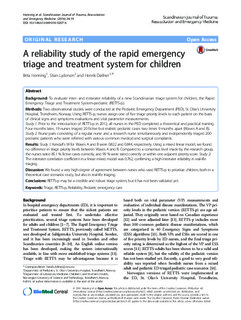| dc.contributor.author | Henning, Brita | |
| dc.contributor.author | Lydersen, Stian | |
| dc.contributor.author | Døllner, Henrik | |
| dc.date.accessioned | 2016-05-12T07:45:25Z | |
| dc.date.accessioned | 2016-05-23T12:18:30Z | |
| dc.date.available | 2016-05-12T07:45:25Z | |
| dc.date.available | 2016-05-23T12:18:30Z | |
| dc.date.issued | 2016-02-24 | |
| dc.identifier.citation | Scandinavian Journal of Trauma, Resuscitation and Emergency Medicine 2016, 24(19) | nb_NO |
| dc.identifier.issn | 1757-7241 | |
| dc.identifier.uri | http://hdl.handle.net/11250/2390033 | |
| dc.description.abstract | Background
To evaluate inter- and intrarater reliability of a new Scandinavian triage system for children, the Rapid Emergency Triage and Treatment System-pediatric (RETTS-p).
Methods
Two observational studies were conducted at the Pediatric Emergency Department (PED), St. Olav’s University Hospital, Trondheim, Norway. Using RETTS-p, nurses assign one of five triage priority levels to each patient on the basis of clinical signs and symptoms evaluations and vital parameter measurements.
Study 1: Prior to the introduction of RETTS-p in 2012, all nurses in the PED completed a theoretical and practical training. Four months later, 19 nurses triaged 20 fictive but realistic pediatric cases two times 9 months apart (Waves A and B). Study 2: Nurse pairs consisting of a regular nurse and a research nurse simultaneously and independently triaged 200 pediatric patients who were referred with various common medical and surgical complaints.
Results
Study 1: Kendall’s W for Waves A and B were 0.822 and 0.844, respectively. Using a mixed linear model, we found no difference in triage priority levels between Waves A and B. Compared to a consensus level made by the research group, the nurses rated 85.1 % fictive cases correctly, and 99 % were rated correctly or within one adjacent priority score. Study 2: The interrater correlation coefficient in a linear mixed model was 0.762, confirming a high interrater reliability in real-life triaging.
Discussion
We found a very high degree of agreement between nurses who used RETTS-p to prioritize children, both in a theoretical case scenarios study, but also in real-life triaging.
Conclusions
RETTS-p may be a credible and robust triage system, but it has not been validated yet. | nb_NO |
| dc.language.iso | eng | nb_NO |
| dc.publisher | BioMed Central | nb_NO |
| dc.rights | Navngivelse 3.0 Norge | * |
| dc.rights.uri | http://creativecommons.org/licenses/by/3.0/no/ | * |
| dc.title | A reliability study of the rapid emergency triage and treatment system for children | nb_NO |
| dc.type | Journal article | nb_NO |
| dc.type | Peer reviewed | nb_NO |
| dc.date.updated | 2016-05-12T07:45:25Z | |
| dc.source.volume | 24 | nb_NO |
| dc.source.journal | Scandinavian Journal of Trauma, Resuscitation and Emergency Medicine | nb_NO |
| dc.source.issue | 19 | nb_NO |
| dc.identifier.doi | 10.1186/s13049-016-0207-6 | |
| dc.identifier.cristin | 1341124 | |
| dc.description.localcode | This article is distributed under the terms of the Creative Commons Attribution 4.0 International License (http://creativecommons.org/licenses/by/4.0/), which permits unrestricted use, distribution, and reproduction in any medium, provided you give appropriate credit to the original author(s) and the source, provide a link to the Creative Commons license, and indicate if changes were made. The Creative Commons Public Domain Dedication waiver (http://creativecommons.org/publicdomain/zero/1.0/) applies to the data made available in this article, unless otherwise stated. | nb_NO |

